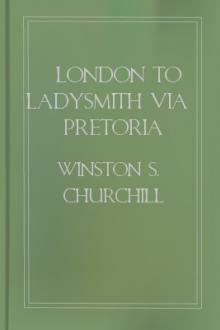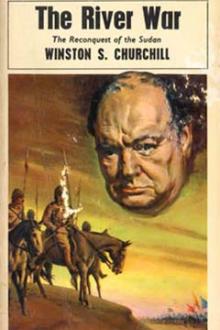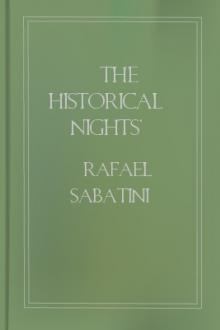London to Ladysmith via Pretoria by Winston Churchill (ereader that reads to you .TXT) 📖

- Author: Winston Churchill
- Performer: -
Book online «London to Ladysmith via Pretoria by Winston Churchill (ereader that reads to you .TXT) 📖». Author Winston Churchill
At eight o'clock the cavalry crossed the river under shell fire directed on the bridge, and were massed at Fort Wylie, near Colenso. I rode along the railway line to watch the action from one of the low kopjes. A capricious shell fire annoyed the whole army as it sheltered behind the rocky hills, and an unceasing stream of stretchers from the front bore true witness to the serious nature of the conflict, for this was the third and bloodiest day of the seven days' fighting called the battle of Pieters.
I found Sir Redvers Buller and his Staff in a somewhat exposed position, whence an excellent view could be obtained. The General displayed his customary composure, asked me how my brother's wound was getting on, and told me that he had just ordered Hart's Brigade, supported by two battalions from Lyttelton's Division, to assault the hill marked '3' on my diagram, and hereinafter called Inniskilling Hill. 'I have told Hart to follow the railway. I think he can get round to their left flank under cover of the river bank,' he said, 'but we must be prepared for a counter-attack on our left as soon as they see what I'm up to;' and he then made certain dispositions of his cavalry, which brought the South African Light Horse close up to the wooded kopje on which we stood. I must now describe the main Pieters position, one hill of which was about to be attacked.
It ran, as the diagram shows, from the high and, so far as we were concerned, inaccessible hills on the west to the angle of the river, and then along the three hills marked 3, 2, and 1. I use this inverted sequence of numbers because we were now attacking them in the wrong order.
Sir Redvers Buller's plan was as follows: On the 22nd he had taken the low kopjes, and his powerful artillery gave him complete command of the river gorge. Behind the kopjes, which acted as a kind of shield, and along the river gorge he proposed to advance his infantry until the angle of the river was passed and there was room to stretch out his, till then, cramped right arm and reach round the enemy's left on Inniskilling Hill, and so crumple it.
This perilous and difficult task was entrusted to the Irish Brigade, which comprised the Dublin Fusiliers, the Inniskilling Fusiliers, the Connaught Rangers, and the Imperial Light Infantry, who had temporarily replaced the Border Regiment—in all about three thousand men, supported by two thousand more. Their commander, General Hart, was one of the bravest officers in the army, and it was generally felt that such a leader and such troops could carry the business through if success lay within the scope of human efforts.
The account of the ensuing operation is so tragic and full of mournful interest that I must leave it to another letter.
CHAPTER XXIVTHE BATTLE OF PIETERS: THE THIRD DAY
Hospital ship 'Maine': March 5, 1900.
At half-past twelve on the 23rd General Hart ordered his brigade to advance. The battalions, which were sheltering among stone walls and other hastily constructed cover on the reverse slope of the kopje immediately in front of that on which we stood, rose up one by one and formed in rank. They then moved off in single file along the railroad, the Inniskilling Fusiliers leading, the Connaught Rangers, Dublin Fusiliers, and the Imperial Light Infantry following in succession. At the same time the Durham Light Infantry and the 2nd Rifle Brigade began to march to take the place of the assaulting brigade on the advanced kopje. Wishing to have a nearer view of the attack, I descended the wooded hill, cantered along the railway—down which the procession of laden stretchers, now hardly interrupted for three days, was still moving—and, dismounting, climbed the rocky sides of the advanced kopje. On the top, in a little half-circle of stones, I found General Lyttelton, who received me kindly, and together we watched the development of the operation. Nearly a mile of the railway line was visible, and along it the stream of Infantry flowed steadily. The telescope showed the soldiers walking quite slowly, with their rifles at the slope. Thus far, at least, they were not under fire. The low kopjes which were held by the other brigades shielded the movement. A mile away the river and railway turned sharply to the right; the river plunged into a steep gorge, and the railway was lost in a cutting. There was certainly plenty of cover; but just before the cutting was reached the iron bridge across the Onderbrook Spruit had to be crossed, and this was evidently commanded by the enemy's riflemen. Beyond the railway and the moving trickle of men the brown dark face of Inniskilling Hill, crowned with sangars and entrenchments, rose up gloomy and, as yet, silent.
The patter of musketry along the left of the army, which reached back from the advanced kopjes to Colenso village, the boom of the heavy guns across the river, and the ceaseless thudding of the Field Artillery making a leisurely preparation, were an almost unnoticed accompaniment to the scene. Before us the Infantry were moving steadily nearer to the hill and the open ground by the railway bridge, and we listened amid the comparatively peaceful din for the impending fire storm.
The head of the column reached the exposed ground, and the soldiers began to walk across it. Then at once above the average fusillade and cannonade rose the extraordinary rattling roll of Mauser musketry in great volume. If the reader wishes to know exactly what this is like he must drum the fingers of both his hands on a wooden table, one after the other as quickly and as hard as he can. I turned my telescope on the Dutch defences. They were no longer deserted. All along the rim of the trenches, clear cut and jet black, against the sky stood a crowded line of slouch-hatted men, visible as far as their shoulders, and wielding what looked like thin sticks.
Far below by the red ironwork of the railway bridge—2,000 yards, at least, from the trenches—the surface of the ground was blurred and dusty. Across the bridge the Infantry were still moving, but no longer slowly—they were running for their lives. Man after man emerged from the sheltered railroad, which ran like a covered way across the enemy's front, into the open and the driving hail of bullets, ran the gauntlet and dropped down the embankment on the further side of the bridge into safety again. The range was great, but a good many soldiers were hit and lay scattered about the ironwork of the bridge. 'Pom-pom-pom,' 'pom-pom-pom,' and so on, twenty times went the Boer automatic gun, and the flights of little shells spotted the bridge with puffs of white smoke. But the advancing Infantry never hesitated for a moment, and continued to scamper across the dangerous ground, paying their toll accordingly. More than sixty men were shot in this short space. Yet this was not the attack. This was only the preliminary movement across the enemy's front.
The enemy's shells, which occasionally burst on the advanced kopje, and a whistle of stray bullets from the left, advised us to change our position, and we moved a little further down the slope towards the river. Here the bridge was no longer visible. I looked towards the hill-top, whence the roar of musketry was ceaselessly proceeding. The Artillery had seen the slouch hats, too, and forgetting their usual apathy in the joy of a live target, concentrated a most hellish and terrible fire on the trenches.
Meanwhile the afternoon had been passing. The Infantry had filed steadily across the front, and the two leading battalions had already accumulated on the eastern spurs of Inniskilling Hill. At four o'clock General Hart ordered the attack, and the troops forthwith began to climb the slopes. The broken ground delayed their progress, and it was nearly sunset by the time they had reached the furthest position which could be gained under cover. The Boer entrenchments were about four hundred yards away. The arête by which the Inniskillings had advanced was bare, and swept by a dreadful frontal fire from the works on the summit and a still more terrible flanking fire from the other hills. It was so narrow that, though only four companies were arranged in the firing line, there was scarcely room for two to deploy. There was not, however, the slightest hesitation, and as we watched with straining eyes we could see the leading companies rise up together and run swiftly forward on the enemy's works with inspiring dash and enthusiasm.
But if the attack was superb, the defence was magnificent; nor could the devoted heroism of the Irish soldiers surpass the stout endurance of the Dutch. The Artillery redoubled their efforts. The whole summit of the hill was alive with shell. Shrapnel flashed into being above the crests, and the ground sprang up into dust whipped by the showers of bullets and splinters. Again and again whole sections of the entrenchments vanished in an awful uprush of black earth and smoke, smothering the fierce blaze of the lyddite shells from the howitzers and heavy artillery. The cannonade grew to tremendous thundering hum. Not less than sixty guns were firing continuously on the Boer trenches. But the musketry was never subdued for an instant. Amid the smoke and the dust the slouch hats could still be seen. The Dutch, firm and undaunted, stood to their parapets and plied their rifles with deadly effect.
The terrible power of the Mauser rifle was displayed. As the charging companies met the storm of bullets they were swept away. Officers and men fell by scores on the narrow ridge. Though assailed in front and flank by the hideous whispering Death, the survivors hurried obstinately onward, until their own artillery were forced to cease firing, and it seemed that, in spite of bullets, flesh and blood would prevail. But at the last supreme moment the weakness of the attack was shown. The Inniskillings had almost reached their goal. They were too few to effect their purpose; and when the Boers saw that the attack had withered they shot all the straighter, and several of the boldest leapt out from their trenches and, running forward to meet the soldiers, discharged their magazines at the closest range. It was a frantic scene of blood and fury.
Thus confronted, the Irish perished rather than retire. A few men indeed ran back down the slope to the nearest cover, and there savagely turned to bay, but the greater part of the front line was shot down. Other companies, some from the Connaught Rangers, some headed by the brave Colonel Sitwell, from the Dublin Fusiliers, advanced to renew—it was already too late to support—the attack, and as the light faded another fierce and bloody assault was delivered and was repulsed. Yet the Irish soldiers would not leave the hill, and, persuaded at length that they could not advance further, they lay down on the ground they had won, and began to build walls and shelters, from behind which they opened a revengeful fire on the exulting Boers. In the two attacks both colonels, three majors, twenty officers, and six hundred men had fallen out of an engaged force of scarcely one thousand two hundred. Then darkness pulled down the curtain, and the tragedy came to an end for the day.
All through the night of the 23rd a heavy rifle fire was maintained by both sides. Stray bullets whistled about the bivouacs, and the South African Light Horse, who had selected a most sheltered spot to sleep in, had a trooper hit. There were a certain number of casualties along the





Comments (0)